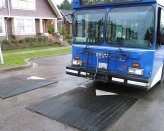Today's Speed Bumps Are Not What They Used To Be...
You no longer need to pour asphalt speed bumps to slow reckless speeders. Modern traffic calming devices are made of ultra-dense recycled rubber or recycled plastic -- they're easy for the non-professional to install and much more environmentally friendly.
These products are cost effective, attractive, and won’t break down in the elements.
Choose the device that fits the zone:

Speed Bumps
- For 5-15 MPH --> Reduce to 2-5 MPH
- Parking lots and Driveways
- Various Lengths: 4',6',9',10', and 12'

Speed Humps
- For 15-30 MPH --> Reduce to 5-10 MPH
- Residential Streets and Campuses
- Adjustable Lengths: Sold as 19.5' Pieces
Thanks to advancements in recycling we now can now grind up five used tires or 132 milk jugs (saving them from the landfill) and mold them into a solid speed bump. The result outlasts asphalt and offers these advantages:
- Less Noise -- Rubber and plastic minimize sound
- Improved Safety and Effectiveness -- No cracked surfaces or exposed hardware
- No Painting -- UV-stabilized color permanently molded into the material
- Simple Install/Removal -- One person, no fancy equipment
- Leadership in Energy and Environmental Design (LEED) Credit
Be proactive!
Speed reduction is essential for safety, increases 'livability,' and helps preserve property values. Communities and public spaces that encourage responsible driving are more people friendly and, ultimately, more inviting for everyone -- including motorists.
Accommodating Emergency Vehicles and Bus Routes:
Option #1: Install a "Split-Hump"
Where there are two opposing lanes of traffic, split speed humps minimize the impact on travel time of emergency vehicles. This method requires installing 2 speed humps -- each covering the necessary width of a lane -- with a distance of at least 50 feet in between.

Because emergency vehicles have automatic right of way, the driver will be able to negotiate split speed humps without slowing down. In fact, several municipal studies on traffic calming confirm split speed humps have a negligible effect on emergency vehicle travel times. Personal vehicles, on the other hand, do not have the right to crossover the median line and will be required to travel over the speed hump.
Option #2: Install a Speed Cushion

Speed cushions are a more expensive option, but they're cut to accommodate emergency vehicle paths. The cushion is exactly 6-feet (72-inches) across. This is the minimum track width of any standard emergency vehicle and will allow buses, commercial trucks and any fire, ambulance, of other first responder to clear without contact.
Please note, this device reduces traffic speeds to 15-20 MPH and may not be appropriate for certain zones.
Accommodating Cyclists and People with Disabilities:
Option #1: Install a "Right Sized" Speed Hump

Recycled rubber speed humps are modular -- sold in individual, 19.5'-wide sections that lock together. This lets you to build the ideal length.
How can this help cyclists and people with disabilities?
Say your target lane is standard width -- 12 feet or 144 inches. By choosing a four-piece speed bump (2 middle sections, 2 end caps), you can cover a 78-inch width, which is greater than the track width of a personal vehicle.
Placing that 4-piece speed bump in the center of the road, leaves 33-inches of uninterrupted pavement on either side. Since the standard width of a wheelchair is 26-inches, as defined by the American Disabilities Association (ADA), this allows ample room.
Option #2: Install a "Split" Speed Bump

If you're responsible for a parking lot or somewhere requiring aggressive speed reduction, the split speed bump method is a great option.
It's pretty simple. Let's say your parking lot has two 12-foot lanes between rows of car stalls. You could buy two 12 foot bumps and cover the entire width. Yet, if you're concerned with access, you'd probably want to get two slightly shorter bumps and install them at the farthest edges of the lanes.
Two 10-foot bumps, for example, would leave a 4-foot gap in the center -- plenty of space for bicycles and wheelchairs through, without allowing cars to avoid the device.
Rubber vs. Plastic - What's the Difference?
Speed bumps, specifically, are available in recycled plastic or recycled rubber. While both options are highly durable and provide the exact same traffic calming benefits, there are a few key differences to note:
Recycled Rubber Speed Bumps:

- Contain "cat-eye" reflectors for maximum visibility at night
- Excellent performance in extreme heat - won't "curl" or misshape
- "Heavy Duty" version for industrial vehicles
Recycled Plastic Speed Bumps

- Lifetime anti-breakage guarantee
- High visibility yellow (non-reflective)-- for daytime or ample street lighting
- Excellent performance in extreme cold
- Economical and light weight

